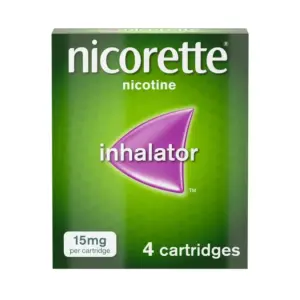Baby and Toddler Multivitamins: What Parents Should Look For on the Label
31 Dec 2025

Quitting smoking is a major step towards better health, but it doesn’t come without challenges. One of the most difficult hurdles is nicotine withdrawal, a set of symptoms your body experiences when it no longer receives nicotine from cigarettes. These symptoms can feel intense at first, but with the right strategies, support, and tools, you can manage them effectively.
Both physical discomfort and psychological cravings are common when you stop smoking. However, they are temporary and treatable. This guide offers clear, practical advice on how to manage nicotine withdrawal in the UK using proven tips and nicotine replacement therapy (NRT). In this blog, you’ll learn how to manage cravings, cope with symptoms, and find effective stop-smoking products that support your journey to a smoke-free life.
What Are Nicotine Withdrawal Symptoms?
Nicotine withdrawal is the body’s reaction to the absence of nicotine, a stimulant that becomes physically and mentally addictive with regular smoking. When you stop smoking, your body begins to reset, but this process often involves uncomfortable symptoms.
Common nicotine withdrawal symptoms UK smokers may experience include:
- Irritability or mood swings: You may feel frustrated or agitated more easily as your brain adjusts to lower dopamine levels.
- Difficulty concentrating: Lack of nicotine can affect focus and short-term memory in the early days of quitting.
- Headaches: Changes in blood pressure and stress levels can lead to mild to moderate headaches.
- Strong cravings: These are triggered both by chemical dependence and familiar routines.
- Low mood or anxiety: Many people feel down or emotionally sensitive as their body adapts to life without nicotine.
- Trouble sleeping: Nicotine is a stimulant, and its absence may temporarily disrupt sleep patterns.
The quit smoking withdrawal timeline varies for each person. Most withdrawal symptoms peak between day 3 and day 7, then gradually ease. Some psychological cravings may last for several weeks, especially when triggered by routine activities.
Why Managing Cravings Matters When You Quit
Cravings are one of the main reasons people relapse after quitting. Understanding them helps you develop better ways to manage them.
There are two types of cravings:
- Physical cravings: Caused by your body’s dependence on nicotine. These tend to be more intense in the early days.
- Psychological cravings: Triggered by habits, emotions, or environments, such as having a coffee, feeling stressed, or socialising.
Key facts about nicotine cravings:
- Most cravings last only 3 to 5 minutes.
- They feel overwhelmed in the moment but fade quickly with distraction.
- Avoiding or reprogramming triggers reduces the likelihood of a relapse.
Managing cravings, stop smoking plans should include:
- Having NRT available when cravings strike.
- Changing routines to avoid common smoking triggers.
- Practicing breathing or mindfulness techniques.
Learning how to cope with nicotine withdrawal is a critical part of building a sustainable, smoke-free lifestyle.
Nicotine Replacement Therapy (NRT)
Nicotine Replacement Therapy (NRT) provides a controlled dose of nicotine without the harmful chemicals found in tobacco. It reduces withdrawal symptoms and helps manage cravings while you gradually reduce nicotine intake.
Types of NRT and how they help:
- Nicotine Patches
- Deliver a steady dose of nicotine over 16–24 hours.
- Discreet and ideal for managing background cravings throughout the day.
- Browse patches from our stop smoking collection
- Nicotine Gum
- Offers fast relief during sudden cravings.
- Satisfies the oral habit associated with smoking.
- Shop nicotine gum
- Lozenges or Microtabs
- Dissolve slowly in the mouth for a steady release.
- Useful when you can’t chew gum or wear a patch.
- Sprays & Inhalators
- Mimic the hand-to-mouth action of smoking.
- Act quickly and are ideal for unpredictable cravings.
- Explore sprays and inhalers
For best results:
- Combine a long-acting product (like a patch) with a fast-acting product (like gum or spray).
- This approach provides 24-hour support while giving you control over breakthrough cravings.
NRT is a clinically proven method to manage the nicotine withdrawal that smokers face every day.
Tips for Managing Nicotine Withdrawal
Creating a quit plan and using consistent daily habits will make it easier to resist cravings and feel in control.
1. Set a Clear Quit Date and Plan Ahead
- Pick a realistic start date and prepare mentally for it.
- Remove cigarettes, ashtrays, and lighters from your home, car, and workplace.
- Let your support network know so they can encourage you.
2. Follow a Structured NRT Schedule
- Use products as directed — don’t wait until cravings hit.
- Consistency prevents nicotine dips that cause intense urges.
- If needed, speak to a pharmacist about adjusting dosages.
3. Distract Yourself During Cravings
- Cravings pass quickly if you redirect your attention.
- Try sipping water, chewing sugar-free gum, stretching, or going for a walk.
- Keep a list of quick distractions handy for those moments.
4. Eat Regular, Balanced Meals
- Low blood sugar can worsen cravings and irritability.
- Eat regularly to maintain energy and reduce mood swings.
- Avoid excess caffeine and alcohol, which may trigger cravings.
5. Get Support
- Join the NHS Stop Smoking Services or support groups.
- Use apps or journals to track progress and setbacks.
- Stay connected to people who support your quit goals.
These nicotine withdrawal tips and tricks make it easier to manage the physical and emotional challenges of quitting.
Common Triggers and How to Overcome Them
Recognising what sparks cravings helps you plan how to handle them.
Common triggers include:
- Morning coffee or tea: Try changing your morning routine or switching to a different drink.
- Stress or anger: Use breathing exercises, stretching, or journaling to calm your mind.
- Alcohol or parties: Reduce alcohol intake or attend events with a support plan in place.
- Socialising with smokers: Politely excuse yourself or bring NRT to manage the moment.
- Driving or commuting: Keep your hands busy with a fidget tool, or listen to music or podcasts.
Learning to avoid or reframe these scenarios is essential in overcoming nicotine withdrawal in real-life settings.
What to Do If You Slip Up
A slip-up isn’t a failure; it’s part of the learning process for many people.
If you relapse:
- Identify what triggered it and how you were feeling.
- Rebuild your plan to avoid similar situations in the future.
- Speak to a pharmacist or a stop smoking adviser about other NRT options.
The goal isn’t perfection; it’s to keep moving forward with the tools that work best for you. Every day without a cigarette counts.
When to Seek Professional Help
If you’re finding withdrawal especially difficult, professional support can make a big difference.
You should speak to a healthcare provider if:
- Symptoms continue beyond a few weeks.
- You feel overwhelmed, anxious, or depressed.
- You’re not getting results from your current NRT approach.
In the UK, you can get free help from:
- NHS Stop Smoking Services
- Your GP or local pharmacy
- Specialist stop smoking advisers
These services offer personalised guidance that makes quitting more achievable.
Buy Stop-Smoking Products
We know quitting smoking is a big step, and you don’t have to do it alone. Our carefully selected range of stop smoking aids, including nicotine patches, gums, lozenges, sprays, and inhalators, is designed to help you manage cravings and stay on track. Whether you’re just starting or need support after a slip, you’ll find what you need right here. Shop now for affordable, effective nicotine replacement products, and take your next step towards a smoke-free life.









free seo backlink generator youtube
I am really impressed with your writing skills and also with the layout on your blog. Is this a paid theme or did you modify it yourself? Either way keep up the excellent quality writing, it’s rare to see a nice blog like this one today..